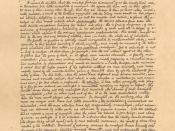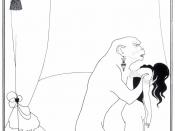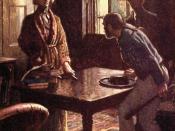In Edgar Allen Poe's short story, 'The Murders in the Rue Morgue', a
classic detective story is played out in a seedy Paris suburb. The story begins as
the narrator meets Monsieur C. Auguste Dupin, a poor but well-read young man.
As they become close friends, they live together in seclusion, departing only
briefly each evening to take introspective strolls along the dark Paris streets.
Soon both the reader and the narrator begin to see Dupin's intimate knowledge
of the human mind, always an underlying element in Poe's prose. Dupin's
extraordinary observances are made by retracing a 'course' of human thought
until an endpoint, the thought that is presently in the subject's head, is reached.
With this still fresh in mind, Poe gives us a mystery taken right from the local
Gazette, two recent murders with questionable motives and circumstances, the
search for the murderer has proved futile.
Poe's stage is now set. The murders,
of Madame and Mademoiselle L'Espanaye are then related by a series of eleven
eyewitnesses, a diverse mix of occupation and culture. However, they concur on
one point: all heard an indistinguishable voice ('that of a foreigner') and one of
an angered Frenchman at the scene of the crime. As the account of the last
witness is registered, Dupin and the narrator decide to examine the apartment
on the Rue Morgue for themselves. The Sherlock Holmes-like protagonist does
not disappoint us. Dupin assures the narrator that he knows who the culprit is,
and he is indeed awaiting his arrival. After collecting evidence and careful
analysis, Dupin seems to have solved the murder beyond the shadow of a doubt.
The strange circumstances lead Dupin to believe that the perpetrator could not
have been human but of the animal kingdom. He cites an orangutan as...


